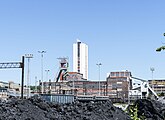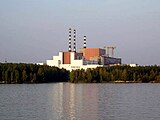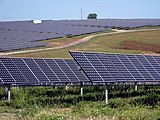Energy in Ventora
The majority of energy usage in Ventora derives from fossil fuel sources. Over the last several decades, nuclear power plants and renewable sources have taken on a greater role in meeting the country's energy requirements. Ventora's electricity generation comes roughly from about a fifth nuclear, a third renewables, and two-fifths fossil fuels. Natural gas is the primary heating fuel outside of urban areas that make use of district heating and is a common cooking fuel as well. Refined petroleum derivatives are the predominant fuel for vehicles, aircraft, and ships.
| Type | Total | Per capita |
|---|---|---|
| Electricity | 1,387,486.6 MWh | 0.0172 MWh |
| Natural gas* | 0.18 BCM | 2.24 m3 |
| Petroleum* | 1,654.0 MBBL | 0.86 gal |
| Coal* | 187,002 t | 2.32 kg |
| *A portion of this source is also included in electricty. | ||
Energy sources[edit | edit source]
Coal[edit | edit source]
Ventora has coal reserves of about 12.45 billion tonnes (13.72 billion short tons), of which 4.1 billion tonnes (4.5 billion short tons) is seen as economically recoverable. In 2017, the country produced 65.1 million tonnes (71.8 million short tons) while consuming 68.2 million tonnes (75.2 million short tons). That same year, Ventora exported 630,265 t (694,748 short tons), requiring the the importation of nearly 3.8 million tonnes (4.2 million short tons) to meet annual requirements despite the country's sizeable reserves.
Anthracite and bituminous coal, both of which are more valuable due to their higher energy densities, make up nearly half of the country's coal deposits. Most anthracite is in ththe Tilarg Mountains region in the east-southeast of the country and involves subsurface shaft mining for extraction. Bituminous coal extraction involves either shaft or surface mining, with most activity in the central-eastern highlands region of the country. The mid-northern region has the largest lignite deposits, accounting for the other half of Ventora's coal reserves. Lignite mining most typically uses open-cast mining techniques.
Beyond coal's typical industrial and electricity generation uses, Ventora has developed substantial coal liquefaction over the last half century. The resulting liquid fuels are often mixed with petroleum derivatives and refinery products to extend their volume, thus reducing the country's dependence on imports. Most common applications include vehicle fuels and industrial processes. The coal-to-liquids processes also yield petrochemical feedstocks. Coal gasification is another growing area for Ventora's coal industry.
About a million lower-income households, mostly in rural areas, relied on coal as a primary fuel for heating, cooking, and lighting as late as the end of the 20th century. This number has been shrinking with the increased availability of electricity and natural gas.
-
Mabato colliery
-
Coal being loaded into a dumper truck at Castirón mine
-
Gipuciras surface coal mine
Natural gas[edit | edit source]
Natural gas consumption in Ventora amounts to 65.85 billion cubic meters (bcm) annually. Although the country has considerable reserves, at an estimated 1940.8 bcm, it only produces about 70% of its yearly needs. As a result, it imports 21.5 bcm despite also exporting 2 bcm each year. The country's major natural gas fields lie in the mid-Kanakan region and the Abayadi Sea. The Directorate for Natural Gas in the Public Works Commission provides oversight of the natural gas system. A multitude of companies are involved in the production, transmission, and distribution of natural gas throughout the country. Customers typically have a choice between gas providers, but each customer is metered and charged for their usage by their provider. Local providers buy gas from regional distributors who are supplied by one or more transmission companies.
Nearly half of the country's natural gas usage goes to electricity generating stations and another third is used in industrial processes. Most of the remainder is consumed predominantly for cooking and domestic hot water. Residential heating is another common gas use where district heating is not available.
Since the early 2010s, the effort to reduce use of two-stroke vehicle engines became increasingly important for both environmental and economic security reasons. Two-stroke engines generate disproportionate tailpipe emissions, a significant concern considering the popularity of STAR and Bego vehicles that used such engines. Newer models now use compressed natural gas (CNG) and, as a result, the number of fuel stations that offer CNG is continuing to grow in number. Increasing use of CNG as a vehicle fuel also reduces dependence on foreign oil since Ventora has adequate natural gas fields but only limited oil reserves.
-
Natural gas system operations center
-
Emgas natural gas processing plant
-
Abayadi Gas platform in the Abayadi Sea
-
Gas meters on an apartment building
-
Compressed natural gas vehicle fueling pump
Petroleum[edit | edit source]
Petroleum continues to be the primary vehicle fuel and source for lubricating oils in Ventora. It also provides the bulk of fuels for aircraft, ships, and boats. With an average daily per capita consumption of 0.86 gallons per day (gpd), the country uses 1,654.06 thousand barrels per day (KBPD). The country has limited oil reserves of about 150 million barrels and low domestic production of 83.45 KBPD. As a result, the bulk of petroleum must be imported, representing nearly 95% of consumption.
-
Ventól petroleum refinery
-
Typical modern petrol station (petrolarium)
-
Mid-century urban petrol station
-
Neighborhood petrol station
Nuclear[edit | edit source]

Having adequate uranium reserves, Ventora began considering nuclear power plants for generating electricity in the mid-1970s. Construction on the first plant began in 1981 and the first unit came online in 1987. Over the last two decades, nuclear power has become an important component in the country's efforts to reduce use of fossil fuels. As a result, the country's electricity-generating reactor fleet has grown to 14 units and two more units are under construction as of 2022.
Ventora's uranium deposits are found in a band including and south of the Kanakan Steppe, dipping into some northern portions of the country's central plains. The heaviest concentrations are in the eastern foothills of this region. The size of the uranium reserves is estimated in excess of 119,000 tons. Currently, seven companies hold licenses for extracting uranium ore and the industry is heavily regulated for safety purposes.
Renewable sources[edit | edit source]
Renewable sources are playing an increasing role in filling Ventora's energy needs, predominantly in the generation of electricity. Hydropower is the longest used but has recently been eclipsed by wind power as the leading renewable energy source. Others include solar thermal energy, the use of which is growing, as well as biomass and geothermal energy. The latter two, particularly waste-to-energy, see some usage in heating and cooling applications in addition to electrical generation. Some biomass is converted to biofuel for use in road and specialty vehicles as well as industrial settings.
Electricity sector[edit | edit source]
Electrical generation in Ventora (2018)
Ventorans consume approximately 506.4 terawatt hours (TWh) of electricity annually for residential, industrial, and commercial purposes. The country has a generating capacity of 525.3 TWh and is a net exporter of electricity.
Generation[edit | edit source]
Several dozen companies engage in the generation of electricity across Ventora. Modes of production include nuclear power plants, renewable sources, and fossil fuel-fired generating stations.
Fossil fuels[edit | edit source]
Nearly 42%, about 219 TWh, of electricity generation in Ventora derives from fossil fuels. Coal, at 77.4% of all fossil fuels, is the largest contributor owing to the country's abundant coal fields. Coal is easily transported to generating stations by barge on the country's extensive navigable river network or by railway. In recent years, several oil fueled plants have been converted to natural gas. This clean-burning fuel represents 17.5% of the fossil fuels used in generating electricity, with the balance being oil.
Although coal will continue to be an inexpensive fuel for many years, oil-fired plants will likely be phased out within the next decade. Presently, most oil-fired plants are used for peaking purposes when demand for electricity is higher than normal. Even so, oil-fired stations presently produce 2.2% of Vespratia's fossil fuel generated electricity.
-
Barlessa coal-fired generating station
-
Nagore oil-fired generating station
-
Canadiense natural gas-fired plant
Nuclear power[edit | edit source]
There are 14 nuclear reactors installed at five electricity generating stations in the country, representing a total installed capacity of 107.2 TWh. This accounts for 20.4% of the country's electrical generation. Another two reactors are under construction. Although co-locating the reactors in fewer stations results in increased electricity transmission requirements, the limited number of sites greatly simplifies operational, security, and emergency planning.
Píjan, the country's first nuclear powered electric generating station, uses two VVER-440 reactors with designs licensed from Velorenkya. The station was built by Atómica SA, a public-private consortium, with technical assistance and oversight, as well as substantial participation, by Velorenkan concerns. Construction began in 1981 and the first unit came online in 1987, followed by unit 2 the following year. Both reactors were uprated from their original 440 megawatt (MW) capacity by 7% to 470 MW each in 2008.
In 1986, construction began on Camoqui station's three VVER-1000 reactors, which came online in 1991, 1992, and 1994, respectively. These reactors are rated at 1,000 MW. Bengo station has five VVER-1000 reactors and was built between 1994 and 2008. Ventora's latest pressurized-water reactor station, Gualalaro, has two VVER-1200 reactors rated at 1,200 MW each. The station was built between 2009 and 2018. Two additional VVER-1200 reactors have begun construction at the station. When completed by 2029, the remaining oil-fired generating plants will be retired, with their peaking duties shifted to natural gas-fired plants.
As part of a plan to manage nuclear waste from the pressurized water reactors, Ventora built a fast breeder reactor at Abesi station. The BN-800 reactor, rated at 830 MW, is a sodium-cooled reactor that uses fuel that incorporates about 20% plutonium derived from reprocessed fuel rods from the country's other reactors. Although this does not eliminate nuclear waste, it plays a role in its reduction. Construction on Abesi station began in 1999 and it began commercial operation in 2021.
-
Píjan nuclear station
Caniza -
Camoqui nuclear station
Xahlan -
Bengo nuclear station
Arava -
Gualalaro nuclear station
Castellano -
Abesi nuclear station
Estevez
Renewables[edit | edit source]
Renewables have grown to account for more than a third (37.8%) of the country's electricity generation capacity, representing 199.1 TWh annually. Significant investment in wind turbines has made wind power the leading renewable source, comprising 36.7% of renewable energy and 13.9% of all electrical generating capacity. Hydro power, primarily in the form of dams with some pumped storage facilities, account for about a third (34.8%) of renewable generating volume. Solar, predominantly in the form of photovoltaic cell farms, provides 12.4% of renewable source generation. Biomass is another renewable source, using agricultural, timber, and other organic waste and byproducts as a combustion fuel for 6.9% of renewable electricity generation. Decomposition gases from solid waste disposal landfills contribute to biomass fuel sources. Geothermal steam, at 3.4%, rounds out the variety of renewable means used for generating electricity.
-
Barano hydro station
Tramullas -
Yaguaquillas wind farm
Sala -
Choleo solar farm
Palmar -
Monla geothermal station
Aurelia -
Kosano waste-to-energy station
Tauro
Transmission[edit | edit source]
Thirty-two different companies operate electric power transmission grids from generating stations to regional distribution systems. This ensures redundancy in the transmission network which the Ventoran Electric Network (Ventoran: Red Eléctrica de Ventorano, REV) oversees from its network operations center in Ascara. REV is an agency in the Public Works Commission's Directorate for Electricity. Automated switchgear can reroute power through other portions of the network when needed to ensure uninterrupted electricity transmission.
Electricity transmission takes place either as high-voltage alternating current (AC) at 60 hertz (Hz) or as high-voltage direct current (DC). The latter is more efficient for long distances while the former is less costly and does not require any current conversion equipment. Most transmission lines are above ground, typically ranging from 110 to 765 kilovolts (kV) for AC or up to 500 kV for DC. Subsurface transmission lines are not common outside of metropolitan areas.
-
REV Operations Center, Ascara
-
Overhead transmission lines
Rejilla Central (220 kV)
Red Eléctrica Centro (380 kV) -
Costero Energía 450 kV HVDC transmission line and converter station
Distribution[edit | edit source]
From the AC transmission lines, power is stepped down to sub-transmission voltages of 25 to 100 kV at electrical substations. Electricity transmitted by DC lines is first converted to AC and then stepped down to sub-transmission voltages. Regional electric power distribution companies, of which there are dozens, then provide the electricity to the local distributors whose lines typically operate at 600 to 35,000 volts. They provide electrical power to end-user customers in residential, industrial, and commercial locations. There are hundreds of local distribution companies across the country.
Service electricity in Ventora is stepped down to 240 volts at 60 Hz AC. The standard connection is a wall outlet, typically with two sockets. The socket has two grounding connectors and two receptacles for the power conductor prongs of the plug. In complementary fashion, the electrical appliance cord plug has two power conductor prongs and grounding strips. Power is not polarized and plugs may be inserted into the socket irrespective of which prong fits into either receptacle.
-
Montertaxo substation
-
Stepdown transformer
-
Typical 2-socket wall outlet
-
Typical appliance electrical connector plug
Cogeneration[edit | edit source]

Several urban areas and many large multi-building campuses, including housing blocks, universities, and government compounds, make use of district heating services. In about half of the plants, refuse, sewerage, and other waste products provide the for fuel for producing the steam for district heating. The other major heat plant fuel is natural gas. Most district heating plants are cogeneration facilities in that they also generate electricity. Some industrial facilities use cogeneration for the production of process steam as well.































